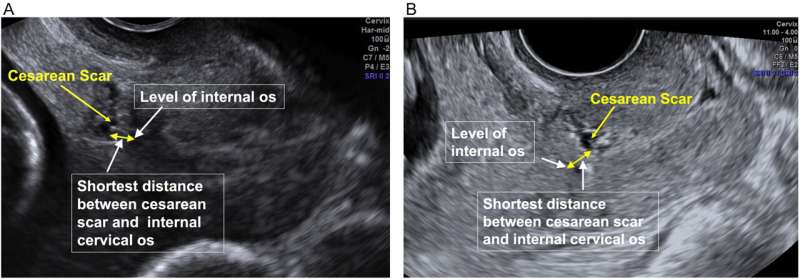This article has been reviewed according to Science X's editorial process and policies. Editors have highlighted the following attributes while ensuring the content's credibility:
fact-checked
trusted source
proofread
Extra one-minute check can stop some babies from being born prematurely

Women who have a cesarean section in the late stages of labor are at increased risk of preterm birth in subsequent pregnancies. But UCL researchers have now found a way to prevent this from happening.
Their study, published in the American Journal of Obstetrics & Gynecology MFM, studied 243 pregnant women who had been referred to a preterm birth surveillance clinic at University College London Hospital between January 2017 to April 2021, who had previously had a late stage C-section in the second phase of labor.
More than 25% of all deliveries in the U.K. are by C-section. Up to 20% of in-labor cesarean sections occur at full dilatation (10 cm) in a late stage of labor, which could affect up to 20,000 women in the U.K. each year.
Women have C-sections at this late stage for a number of reasons, such as the baby having heart rate abnormalities or avoiding difficult instrumental delivery.
However, this can increase the risk of preterm birth in subsequent pregnancies from 2% to 15%.
The team used a validated transvaginal ultrasound technique—which they developed in 2022—to assess the position of the women's C-section scar in relation to their cervix (neck of the womb).
An ultrasound probe was inserted into the vagina and gently moved on either side to assess the cervical length and the height of C-section scar.
If researchers were unable to see a C-section scar, then they found that the women were unlikely to have a preterm birth.
However, if the scar was low down the womb or within the cervix then there was a much higher chance of the cervix becoming short in mid-pregnancy and of women then delivering preterm.
To prevent this from happening, the researchers found that placing a small stitch around the cervix lowered the risk of preterm birth to 4.1% in their patients. The stitch, called a cervical cerclage, can be placed as a day case surgical procedure with excellent outcomes.
Corresponding author and obstetrician, Professor Anna David (UCL EGA Institute of Women's Health and UCLH), said, "Cesarean sections are low risk if you have one in early labor or before labor starts. But couples and midwives need to be aware of the risks of having a C-section in the late stages of labor particularly at full dilatation.
"It's important that people know the link between late-stage C-sections and preterm birth so that they can be referred to a clinic for appropriate assessments and interventions to improve their outcomes.
"The treatment that we have outlined is already available as part of routine NHS care. The guidance in Saving Babies' Lives Version Three says that women with a previous full dilatation C-section should have a routine cervical length scan between 16 and 20 weeks. But training for this is not optimized and, often, clinicians are not aware that C-section scars can be visualized by ultrasound."
A preterm birth is one that happens before 37 completed weeks of pregnancy. There were about 53,000 babies born prematurely in 2021, in the U.K. And, in England and Wales, 7.6% of births were preterm—an increase from 7.4% in 2020.
Although each case is individual, generally, the earlier a child is born, the higher their risk of problems. And around 1 in 10 of all preterm babies will have a permanent disability such as lung disease, cerebral palsy, blindness or deafness.
Professor David said, "The assessment of C-section scar characteristics and position is easily incorporated into routine antenatal surveillance, taking only an extra minute to perform during transvaginal ultrasound.
"If, from this, we can identify women with a short cervix and put a stitch in place, it reduces the risk of preterm birth massively—improving outcomes for both mother and child.
Lead author and Ph.D. researcher, Dr. Amrita Banerjee (UCL EGA Institute of Women's Health), said "Assessing the C-section scar characteristics may help clinicians work out a more personalized risk of preterm birth and optimize the management plan for each pregnant woman in their care.
"We hope this will help to reduce rates of preterm births and prevent future baby loss."
The researchers are now developing a training package and aim to further validate their findings in a multi-center study, involving teams across England.
More information: Amrita Banerjee et al, Prediction of spontaneous preterm birth in women with previous full dilatation cesarean delivery, American Journal of Obstetrics & Gynecology MFM (2024). DOI: 10.1016/j.ajogmf.2024.101298




















